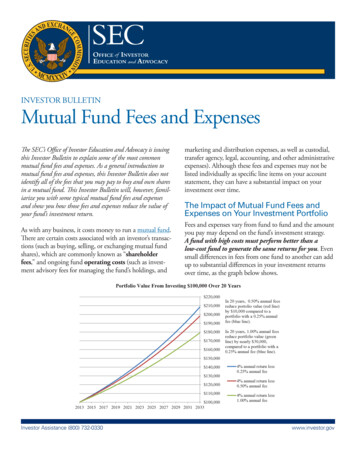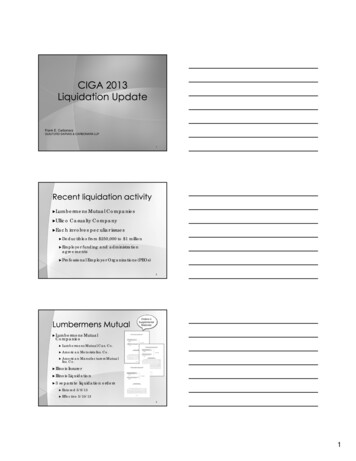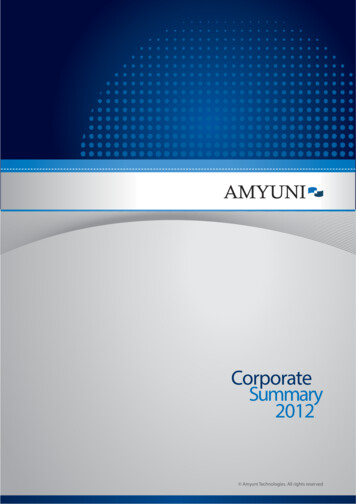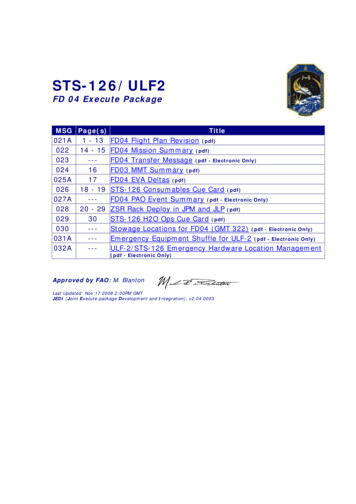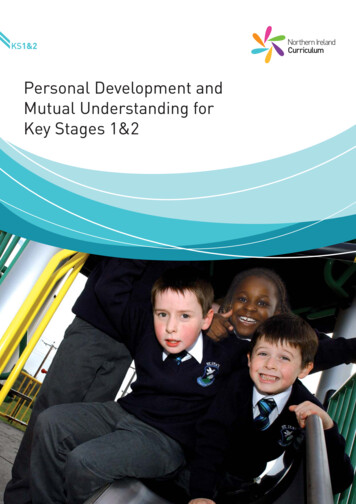
Transcription
CONTENTSIntroduction to the Guidance1The Rationale for PersonalDevelopment and MutualUnderstanding3Implementing PD&MU5Teaching, Learning & AssessingPD&MU9Appendix 1: Statements ofMinimum Requirement18
AcknowledgementsThe Partnership Management Board would like to thank the many people whocontributed to the development and production of the contents of this pack.They include colleagues from:Council for the Curriculum, Examinations and Assessment (CCEA)Council for Catholic Maintained Schools (CCMS)The Education and Library BoardsRegional Training Unit (RTU)Classroom 2000 (C2K)The Partnership Management Board would also like to thank all the schools whoso generously allowed us to take photographs. Their participation celebrates pupilsenjoying learning. Their involvement makes the materials real.
Personal Development and Mutual UnderstandingIntroduction to the GuidancePersonal Development and Mutual Understanding (PD&MU) is a new statutoryrequirement in the Revised Curriculum. This document provides a startingpoint for reflection and whole-school review and will help your schoolimplement PD&MU at Key Stage 1 and Key Stage 2.This guidance will: explain what PD&MU is, why it is important and describe its place within theRevised Curriculum; explain how to implement PDΜ discuss suitable teaching, learning and assessment strategies for PDΜand relate PD&MU to broader aspects of school life.Personal Development and Mutual Understanding does not begin or end atschool. The environment created in school is only part of the wider world thatchildren inhabit. We know that children are greatly influenced by society’svalues – especially by religious beliefs, parental values, the media and theirpeers. Consequently, PD&MU provision is most effective when it is basedon a consistent approach and where the responsibility is shared by parents,teaching and non-teaching staff, children, health professionals, relevantexternal agencies and the local and wider communities. Close consultationwith these ‘partners in education’ needs to be an essential element of theplanning, implementation, evaluation and review of your PD&MU programme.1
Assessmentfor LearningKeyStages 1&2Who is this Guidance for?This guidance has been written for principals, senior managers, teaching staffand governors of primary schools.Your school’s principal and senior management team have a key role indeveloping and implementing PD&MU. This role involves setting up a workinggroup to consult with governors, staff, parents, health professionals, childrenand other relevant community representatives to develop a policy andprogramme for PD&MU. This working group must be managed by aco-ordinator who will facilitate a genuinely open and collaborative process ofimplementation.Your school’s teachers also have a significant role in both the planning anddelivery of the PD&MU curriculum. They have detailed knowledge of the needs,age, maturity, stage of development and family background of the childrenin their classrooms and they are responsible for guiding and facilitatinglearning. The personal qualities of your school’s teachers are paramount inestablishing a learning environment that supports PD&MU. Teachers whoare genuine, demonstrate empathy, have an unconditional positive regard forchildren and a capacity for listening to others will ensure that children learnmore effectively. We encourage your teachers to reflect critically on their ownpractice, and it may be useful to also ask children at your school to reflect onpractice in the classroom. Some of your school’s teachers may believe thatthey are inadequately trained in active learning strategies, or they may initiallyfeel uneasy discussing some areas of PD&MU with children. Your school mustaddress this issue by providing training opportunities for your teaching staffsuch as in-service courses, directed time after school and staff developmentdays.Finally, governors must foster and support the implementation of PD&MU bycollaborating with teachers and parents. They need to facilitate an inclusiveconsultation process that involves the entire school community. Governorsalso need to examine and approve the proposed PD&MU programme prior toits implementation in the school and should review it at regular intervals.‘What are required are enthusiastic principals with vision to be strongadvocates for young people and to create schools that take a child-centred,caring ethos, reflecting the values and approaches associated with personaldevelopment.’Leitch et al, 2005.2
CPD Unit 1 explores the rationalefor Personal Developmentand Mutual Understanding.Personal Development and Mutual UnderstandingThe Rationale for PersonalDevelopment and MutualUnderstandingThe Revised Curriculum sets out a single broad aim for education:‘To empower young people to develop their potential and to make informedand responsible decisions throughout their lives.’You may already provide significant opportunities within and beyondyour school’s curriculum to help children acquire skills, knowledge andunderstanding. The Revised Curriculum seeks to build on what you are alreadydoing well to prepare young people for life, work and the challenges of beingan adult in an increasingly complex society. Personal Development and MutualUnderstanding is a separate Area of Learning in the Revised Curriculum.It focuses attention on children’s emotional development, health and safety,relationships with others and development of moral thinking, values andactions. CCEA describes PD&MU as:‘Encouraging each child to become personally, emotionally, socially andphysically effective to lead healthy, safe and fulfilled lives and to becomeconfident, independent and responsible citizens, making informed andresponsible choices and decisions throughout their lives.’Personal Development and Mutual Understanding concentrates on thedevelopment of children’s: knowledge; attitudes; skills; relationships; behaviour that can be utilised in and outside the classroom; thinking skills and personal capabilities; emotional awareness; values; and life skills.3
Assessmentfor LearningKeyStages 1&2Benefits to Your School, Children, andLocal CommunityThere is growing evidence to support the inclusion of PD&MU in the RevisedCurriculum. An effective Personal Development and Mutual Understandingprogramme will benefit your school, children at your school and your localcommunity. The table below highlights these benefits.Your schoolChildren at your schoolYour communityYour school will developa supportive learningenvironment that is:Children will develop:Your local community willgain citizens who: challenging andengaging; relevant and enjoyable; active and hands-on; skills integrated; and enquiry-based.This will, in turn, create: a more openrelationship betweenyour staff and childrenat your school; raised standardsof achievement bychildren who feel moresecure, motivated andconfident and who areindependent learners; an improvement in thehealth and well-beingof children in your care;and an inclusiveenvironment where allare valued and have avoice.4 self-confidence and self-esteem; insights into their emotions andattitudes; moral thinking, values andactions; an understanding of the benefitsand importance of a healthylifestyle; skills for keeping safe; an ability to cope with difficultsituations; an understanding of learningdispositions; an ability to work effectively withothers and to take responsibilityfor themselves; insights into society and othercultures, our interdependenceand the need for mutualunderstanding and respect; an ability to use these insightsto contribute to relationships,family life, the local and globalcommunity and the environment; an awareness of the immensevalue of personal andinterpersonal skills in future lifeand employment contexts; knowledge and understanding ofthe challenges and opportunitiesthey may encounter in anincreasingly diverse society; the skills, attitudes and valuesnecessary for independent living,informed decision-making andresponsible action throughouttheir lives; and an understanding of their rolein working for a more inclusive,just and democratic society. have a sense of personaland social responsibility; demonstrate positive andhealthy behaviours; show a concern forothers; are open to new ideas; have integrity and moralcourage; show respect; and are confident,responsible andcontributing members ofthe community.
CPD Unit 2 looks at theStatements of MinimumRequirement for primary schools.Implementing PD&MUPersonal Development and Mutual Understanding is one of the six Areas ofLearning in the Revised Curriculum for primary schools. From Foundationto Key Stage 2, PD&MU is delivered through two interconnected strands andteachers must use these strands to deliver the nine statutory Statementsof Minimum Requirement. The Statements of Requirement are divided intothemes. The table below outlines the two strands of PD&MU.ThemesStrand IPersonal Understanding and HealthAddresses personal and emotionalissues as well as health, well-beingand safety mattersStrand IIMutual Understanding in the Localand Wider CommunityExamines issues relating topersonal and social relationships,interdependence and the need formutual understanding and respect inthe community and in the wider world self-awareness feelings and emotions learning to learn health and safety relationships rules, rights andresponsibilities managing conflict similarities anddifferences learning to live asmembers of thecommunityThe Personal Development and Mutual Understanding curriculum is drawnup in a spiral manner, where similar content is revisited at each Key Stage.However, the strategies, approaches and information adopted at each KeyStage reflect the differing needs and abilities of those children. Therefore, theknowledge and skills gained from PD&MU accumulate as children progressthrough the Key Stages. The Minimum Requirements for PD&MU also providestudents with a basis for Learning for Life and Work at the post-primary phase.Appendix 1 provides detail of the progression in the Statements of MinimumRequirement from the Foundation level through Key Stages 1, 2 and 3. Furtherdetails on Personal Development and Mutual Understanding is available atwww.nicurriculum.org.uk.Education is not just about learning cognitive skills. It is also about helpingchildren to learn about themselves, to be able to live peaceably withthemselves and with others and to help them to develop into competent,mature, self-motivated adults.’Dennis Lawrence, ‘Enhancing Self-Esteem in the Classroom.’ (2006)5
Assessmentfor LearningKeyStages 1&2Delivering Protective FactorsResearch indicates that your school’s PD&MU programme should integrate thefollowing protective concepts: Risks and protective factorsEducating children about risks and how to protect themselves from dangerhas a significant impact on their health and well-being. Young peopleare less likely to endure substance abuse, teenage pregnancy, crime andmental health issues when risk factors are reduced and protective factorsare enhanced. Emotional and social health and life skillsResearch shows that teaching emotional and social health in the classroomleads to increased attachment to school and improved examinationscores. Children who engage in positive relationships and healthy socialinteractions tend to achieve above average academically.Teaching life skills in the classroom has been shown to substantially reducetobacco, alcohol, and illicit drug use. However, to ensure children reallyunderstand and can use life skills they must be anchored by connections tothe other protective concepts. A programme of PD&MU delivered across allAreas of Learning can offer this connectivity.6
Personal Development and Mutual Understanding Self-esteemAny child’s difficulties in learning (or any reluctance to learn) may be causedmore by poor self-esteem, a lack of motivation or fear of failure than a lackof ability. Children need to see themselves as worthy and capable if they areto take responsibility for their learning. A child’s self-esteem can be the keyto their learning success. Children’s self-esteem is largely moulded by thesignificant adults around them: parents, carers, teachers, and (as they growolder) their peers. Your school has an important part to play in promotinghealthy behaviours as well as successful learning. Through PD&MU, youcan create climates and teaching practices that honour and meet thesedevelopmental needs. ResilienceYoung people need to develop strength of character and the ability to adjustto pressure, bounce back from adversity and develop the social, academicand vocational competencies necessary to do well in life. These are allforms of resilience, an attribute that can be developed and fostered. Thefollowing protective factors build resilience, and these can be developedwithin your school: positive bonding; clear and consistent boundaries; life skills; care and support; high expectations; and meaningful participation.7
Assessmentfor LearningKeyStages 1&2Links Across the CurriculumAny provision of Personal Development and Mutual Understanding shouldinvolve links across the curriculum to other Areas of Learning. The table belowillustrates how you can create these links.8Area of LearningLink to PD&MUThe Arts Focus on aesthetic and emotional development. Develop children’s social skills through group work. Help children find a range of ways of communicatingand expressing feelings and emotions through art anddesign, music and drama.Language and Literacy Help children develop a vocabulary to discussemotions and feelings through talking and listening,reading, writing, drama and role play.Mathematics andNumeracy Use statistical data to inform children about PD&MUissues.Physical Education Help children develop self-esteem, confidence and anunderstanding of the relationship between physicalactivity and good health. Allow children to work with others and develop anunderstanding of fairness and how to treat others withrespect.The World Around Us Help children develop insights into their own talents,thoughts and feelings by comparing and contrastingthese with the experiences and feelings of people inother places and times. This should involve the use oflocal and global examples.
CPD Unit 3 reviews theimportance of a positiveschool ethos.Personal Development and Mutual UnderstandingTeaching, Learning andAssessing PD&MUEffective Personal Development and Mutual Understanding doesn’t justdepend on the taught curriculum and the context in which this learning areais experienced. Your school’s ethos and climate, and the ways in which yourschool utilises the expertise of those in its community, are also important.Planning for Personal Development and Mutual Understanding must take intoaccount your established school ethos, build on the existing good practice andreflect how you and your colleagues can promote the all-round developmentof your school’s children. Advice on planning is available in Planning for theRevised Curriculum at Key Stages 1 and 2, which is located in your RevisedCurriculum Support and Implementation Box.The Importance of TrustThe creation of trust between children at your school and members of yourstaff is fundamental to the success of Personal Development and MutualUnderstanding, even if a trust relationship is established with only onemember of staff. Children work harder and work together with people whocare about them and that they trust. Your school must foster an environment inwhich children feel: fairly treated; safe both physically and emotionally; close to others; and part of the school.Each member of your staff has a role to play in developing relationships withchildren at your school. Your staff can convey care and support to children by: listening to them; validating their feelings; demonstrating kindness; and showing them compassion and respect.‘Next to the family, schools have the potential to shape and nurture theskills, well-being and potential of our young people in Northern Ireland.’Sipler, 2006.9
Assessmentfor LearningKeyStages 1&2Creating a Positive Learning Climate andEnvironmentA caring classroom environment is an essential foundation for supportingacademic success, and a safe and secure environment provides a contextwithin which issues may be addressed in a positive way. A positive learningenvironment allows children to express their views honestly and openly and todiscuss challenging topics without fear of reprisal or judgement from others.In PD&MU this environment is particularly necessary, as the topics covered aspart of this Area of Learning may elicit extreme or even ‘inappropriate’ viewsfrom your school’s children. In a positive learning environment, this presentsan opportunity for profound learning – one where children are encouraged tochallenge and discuss viewpoints and the way in which they were expressed.There are a number of useful strategies for creating a safe, secureenvironment that encourages participation and models democratic values.These include: circle work; active-listening skills; cooperative games; and ground rules/contracts or a classroom charter.10
Personal Development and Mutual UnderstandingA classroom charter is an agreement about the ways in which the PD&MUclassroom will operate. It clarifies expectations of behaviour both inside andoutside of the classroom. Expectations about children’s behaviour should beclearly written, communicated and coupled with appropriate consequencesthat are consistently enforced. We suggest that your school’s teachersdevelop the charter by negotiating its contents with children in their class.When teachers impose an agreement rather than negotiate it, they miss animportant learning opportunity and children are less likely to develop a senseof ownership. The negotiation can be an important step in developing an openand trusting atmosphere in the classroom. In some cases, your teachers mayalso choose to involve teaching and learning assistants, senior managementand parents.When agreeing a classroom charter, have your school’s teachers and childrendiscuss the following: why a classroom charter is useful; what the classroom charter should be about; the needs and wants of those directly or indirectly involved in the life of theclassroom; what conditions the teacher needs to be able to teach effectively; what conditions the children need to learn effectively; how the teacher and children will interact; how controversial issues will be managed; and what happens if someone breaks the classroom charter.The final agreement should be written and displayed. It should be referred tofrequently and amended as required, and children should be encouraged totake responsibility for the effective implementation of the agreement.CPD Unit 3: Learning Environment and Methodologies introduces andhighlights the key issues in creating a learning environment conducive forPersonal Development and Mutual Understanding. Please note: if yourschool already has recent, relevant information based on previous schoolimprovement work, for example TTI, Health Promoting School audit orSETAQ, it may be unnecessary to complete this CPD Unit.11
Assessmentfor LearningKeyStages 1&2Learning Approaches and MethodologiesThe approaches and methodologies used in Personal Development andMutual Understanding are crucial to its effectiveness. As PD&MU is very muchabout the development of values and attitudes, it is extremely important thatchildren have an opportunity to develop these naturally as a consequence oftheir investigations and guided critical reflection on issues. To ensure childrenat your school benefit as much as possible from PD&MU, we recommend thatyou: use active and participatory learning methods; follow an issues-based approach; and explore your pupils’ and society’s attitudes and beliefs.Active and participatoryActive and participatory learning approaches are most effective for delivery ofPersonal Development and Mutual Understanding. By encouraging children atyour school to investigate issues for themselves, to suggest solutions and tomake decisions based on what they have learned, you will significantly fostertheir self confidence, self-discipline and self-control. When children are givenopportunities to become actively engaged in their learning at different levelsthey: experience and discover learning for themselves; construct new meanings and acquire new understanding; take increasing responsibility for their learning; become more critical and discerning; and are able to transfer the learning to different situations.Your school’s teachers should help children explore issues that are relevantto their needs, interests and experiences using a variety of active learningapproaches. For example, children will learn more about fairness by actuallyengaging in and experiencing democratic processes in the safe forum of theclassroom or school than from reading about it in a book.12
Personal Development and Mutual UnderstandingThe model below highlights the learning cycle for active learning:Setting GoalsConnecting theLearningPlanning forLearningPreparing forLearningLearning CycleReviewing theLearningLearning ActivitySharing theLearningIn this cycle children start with what they already know, explore the learningpossibilities available, question the learning, draw conclusions and reflect onthe outcomes. It is essential that children progress through the various stagesof the learning cycle to make sense of the learning and make new connections.The main benefits of active learning are as follows: It places children at the heart of the learning process. The teacher acts as a facilitator who guides and directs the learning. Children learn more when they can make sense of what they are learning. It can be carried out by groups or individuals. It promotes action and generates high levels of interaction and stimulatingdiscussion. It encourages collaborative ways of working. It engages all children at different levels.13
Assessmentfor LearningKeyStages 1&2A wide variety of active learning methodologies are available to support yourteachers’ various learning aims. Some suggestions are highlighted in the tablebelow:Learning AimMethodologyGenerate a number of ideas quickly. BrainstormConsider a specific situation. Role play Visitor TechniqueLearn to negotiate, listen to and supporteach other. DramaPromote cooperation. Co-operative gamesQuestion information presented. Use photographs/pictures as astimulus Use media television advertisementsGather own thoughts and take aviewpoint. Open-ended statementsExpress own opinions, promote criticalthinking, and respect the views ofothers. ‘Agree or disagree’ continuumsPromote communication and criticalthinking. Circle time Twos to Fours Story-tellingRepresent ideas or concepts. Collage workExplore issues of bias and stereotyping. Freeze FramesGather information, record findings andinterpret data. Hot Seating Questionnaires and surveysFurther details on teaching methodologies and their explanation is available inthe Active Learning and Teaching Methods booket in your Curriculum Support andImplementation Box.14
CPD Unit 3 Learning Environment andMethodologies examines a range ofappropriate learning and teaching strategiesin the context of Personal Development.Personal Development and Mutual UnderstandingEnquiry-basedEnquiry-based learning approaches allow children to develop a greaterunderstanding of the complexity of certain issues, to express their own andothers’ opinions, and to make choices about their own learning. One way youcan introduce this method is to incorporate current local and global issues intoclassroom enquiry activities. The issues should be relevant to the interests ofchildren at your school or be considered because of questions posed by thechildren themselves. It is not necessary to find answers to all of the issues.Values-basedPersonal Development and Mutual Understanding encourages children to takeresponsibility for their own values and actions. Your school’s teachers canuse human rights instruments such as ‘The Universal Declaration of HumanRights’, the ‘UN Convention on the Rights of the Child’ to provide a contextwithin which your children can clarify and consider their own values andexplore alternatives. Your PD&MU programme should: encourage them to explore the impact of human rights principles on theirown lives; and encourage them to examine the impact of human rights on the classroomcommunity (for example by negotiating the classroom charter).It’s important to remember that values are not formulated in a vacuum. Theyare promoted and actively encouraged in the home and your school and societyas well as in your school. You can help your school’s children realise thatvalues and opinions are influenced by society by encouraging them to: answer specific questions that are relevant to the PD&MU issue being dealtwith during self-assessment exercises; then collate personal responses to ascertain group response; and finally compare both children’s personal responses and the group’s response tothe recognised socially acceptable responses.Emotional dimensionFrom time to time, Personal Development and Mutual Understandingissues may result in conflict. All conflicts have both rational and emotionaldimensions. Your school’s PD&MU provision must allow children to exploreways to manage conflict, manage their own emotions and show sensitivityto the emotions of others. This emotional dimension has importantconsequences for teaching and learning approaches, especially whenexploring controversial or sensitive issues. Further information about how tomanage such issues in safe and appropriate ways is available atwww.nicurriculum.org.uk.15
Key Stages 1&2AssessmentAssessment in Personal Development and Mutual Understanding is asimportant as in any of the other Areas of Learning. However, be aware thatwhen assessing children’s Personal Development and Mutual Understanding,it’s unlikely that progression will be linear. Personal rates of developmentare not and cannot be standardised. With this in mind, assessment andreporting should take account of and reflect each child’s current strengthsand developmental needs. It is possible for a ten year old to be at a veryearly stage in some aspects of his or her Personal Development and MutualUnderstanding while a much younger child, for a variety of reasons, might beat a later stage. For some children, moving on from an early stage of PersonalDevelopment and Mutual Understanding might not prove possible.You need to ensure that throughout your school assessment of PersonalDevelopment and Mutual Understanding is concerned with: knowledge and understanding; and the child’s ability to demonstrate the skills that are being learned andpractised.You must also recognise the importance of self-assessment. This is a skillthat needs to be learned and practised. We recommend using teaching andlearning approaches that encourage children to recognise the processes oftheir own learning. These include: reviewing progress; setting targets; negotiating their own pathways; and recording their achievement.Encouraging children to talk about and reflect upon activities and situationsin which they have been involved will also help them to learn to use theirjudgement when considering: what they have done; what the consequences were; how they felt about it; what they might want to do differently in future; and how they might go about achieving changes.16
Personal Development and Mutual UnderstandingMore information on assessment methods and self-assessment is availablein the Assessment for Learning guidance booklet located in your RevisedCurriculum Support and Implementation Box.Finally please note that there are some areas of a child’s PersonalDevelopment and Mutual Understanding that should not be the subject offormal assessment. The ‘worth’ of any child should never be in question, norshould there be final or simple judgements made about values and decisionsthat children appear to favour. Opinions can be expressed, informationgathered, debate can ensue, but final decisions on personal matters mustremain the responsibility of the individual concerned.17
Assessmentfor LearningKeyStages 1&2Appendix 1: Statements of MinimumRequirementTHEME 1: SELF–AWARENESSFoundation StageKey Stage 1Key Stage 2Key Stage 3Teachers should enable pupils to develop knowledge, understanding and skills in developing:Strand 1Strands 1 and 2Strands 1 and 2themselves and theirpersonal attributes.their self-esteem andself-confidence.their self- esteem, selfconfidence and how theydevelop as individuals. Explore who they are. Recognise what theycan do. Identify their favouritethings. Recognise what makesthem special. Feel positiveabout themselves,and develop anunderstanding oftheir self-esteem andconfidence. Become aware oftheir strengths,abilities, qualities,achievements,personal preferencesand goals.18 Develop selfawareness, selfrespect and selfesteem. Know how toconfidently expresstheir own views andopinions in unfamiliarcircumstances. Identify currentstrengths andweaknesses. Face problems, tryingto resolve and learnfrom them. Recognise howresponsibilities changeas they become olderand more independent. Explore and examinewhat influences theirviews, feelings andbehaviour. Develop strategies toresist unwanted peer/sibling pressure andbehaviour.Personal DevelopmentKey Concept:Self-Awareness Explore and express asense of self. Investigate theinfluences on a youngperson. Explore the differentways to develop selfesteem.
Personal Development and Mutual UnderstandingTHEME 2: FEELINGS AND EMOTIONSFoundation StageKey Stage 1Key Stage 2Key Stage 3Teachers should enable pupils to develop knowledge, understanding and skills in developing:Strand
Personal Development and Mutual Understanding 1 Introduction to the Guidance Personal Development and Mutual Understanding (PD&MU) is a new statutory requirement in the Revised Curriculum. This document provides a starting point for refl ection and whole-school review and will help your s






